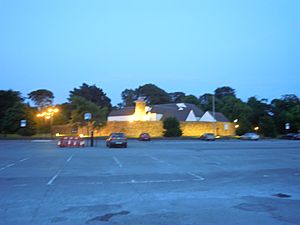Siamsa Tíre facts for kids
Siamsa Tíre is a special place in Tralee, County Kerry, Ireland. It's known as Ireland's National Folk Theatre. This means it's a main home for traditional Irish music, dance, and storytelling. You can find it in Tralee Town Park.
Contents
What Does Siamsa Tíre Mean?
The name Siamsa Tíre comes from the Irish language. It's pronounced "Shee-am-sa Tee-ra." The word "Siamsa" means fun, music, and entertainment. "Tíre" means "of the land." So, it's like "entertainment of the land."
What Happens at Siamsa Tíre?
Siamsa Tíre has a group of professional performers. Many of them come from the local community. They are trained in a special Siamsa style. These performers work together to put on many shows each summer.
Since 1991, Siamsa Tíre has also been an arts centre. This means it hosts many different events all year round. You can see modern plays, dance shows, and classical music concerts. They also have comedy acts and literary events. There are art shows in their galleries too. These shows often explore themes of folk culture. Siamsa Tíre also welcomes artists to stay and work there. They often take their National Folk Theatre shows on tour to other places.
In recent years, Siamsa Tíre has been exploring new ways to share folk culture. This includes projects that mix different art forms. For example, they combine modern dance with visual arts.
The History of Siamsa Tíre
How Siamsa Tíre Started
The story of Siamsa Tíre began in 1957. A priest named Father Pat Ahern came to Kerry. His goal was to start a choir at St John's church in Tralee. Later, in 1963, a play called "Golgotha" was performed. The group that grew from these early efforts called themselves "Siamsóirí na Ríochta."
This performing group traveled around Ireland. They even performed at the famous Abbey Theatre. They were also invited to be on TV shows. In the late 1960s, the group started putting on shows every summer. This became the first "Summer Season" for Siamsa Tíre.
Building the Theatre
In 1974, a company called Siamsa Tíre Teo was formed. Father Pat Ahern became the artistic director. He held this important role until 1998. Another key person was Martin Whelan. He started as a volunteer. Later, he took on a full-time job. In 1974, he became the manager of Siamsa Tíre. He stayed in this job until he passed away in 2002.
Martin Whelan, Father Ahern, and an architect named Patrick O’Sullivan were very important. They helped build the theatre and arts centre that stands today in Tralee. They even traveled to the United States to study other arts buildings. The current theatre and arts centre officially opened in 1991. Before this, Siamsa Tíre had several temporary homes. These included the Ashe Memorial Hall and the old Theatre Royal in Tralee.
See also
 In Spanish: Siamsa Tíre para niños
In Spanish: Siamsa Tíre para niños


